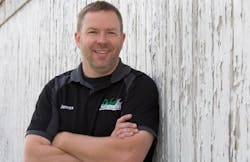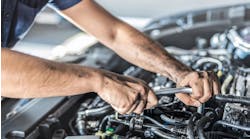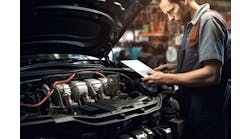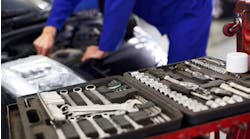The other half, Church says, drive directly to his automotive shop, Oxford Automotive, which sits on his father’s 50-acre farm. The shop doesn’t get drive-by customers—they simply have no way of seeing it.
“We’re in a direction that people just don’t drive,” Church says. “It’s in the north suburbs of Columbus, and people really don’t come out here.”
Over the years, James Church has had to get creative to get his desired customer base out to his shop from the Columbus area, which means making his shop a destination for drivers who live 15–20 miles away. Through these efforts, he’s been able to drive his average repair order up to $580, with an annual revenue of $845,000.
Since inheriting the shop in 2000, Church has created a robust rental car program (where a shop worker picks up and drops off a vehicle directly to the customer), and also worked to make his shop a welcoming destination for those who do want to make the trek. These efforts culminated in success for the shop and a new expansion, which Church hopes will further grow his customer base.
Making it convenient for customers.
When he was 27, Church inherited Oxford Automotive from his father, Dick. Dick started the shop in 1979 on his 50-acre farm after deciding to take on repair full time. Growing up, Church saw firsthand how the shop’s rural location forced them to think outside of the box to attain new customers.
Oxford Automotive sits in the Northeast corner of Bell County. The way Church explains the county, the southern part of the county is growing rapidly, and has a very high per capita income. The north part of the county is the capital of cheap auto repair, he says, with no zoning laws or rules, and very low labor rates, which can attract anybody who wants to work out of his or her garage.
When Church got started as an owner, he took a map of the township and went door to door hitting most of the neighbors around him. He also walked into nearly every business within a 20-mile radius, and followed up with mailings that promoted his business.
Church now has an Excel spreadsheet of about 350 businesses that he made contact with in this way. He says he’s had customers come in for the first time months, and even years, after he initially visited with them. Outside sales efforts in 2017 brought in 17 customers who spent $11,506 on their first visit, and another $9,173 on return visits.
Church knew that his best customers were 15–20 miles away in the southern part of the county, but those customers had little desire to drive that far north when there were other repair shops right next to them. He invested a lot of capital in this property with very little rent, so it didn’t make sense for Church to leave that behind and move downtown to a high rent location. Therefore, he had to get creative.
“I started thinking, ‘Why don’t we get a driver to drive these cars to people? Then they don’t have to come to us at all,’” Church says.
He hired two retired workers to drive the rentals directly to customers, and his 82-year-old father helps tow cars, if needed.
Church started his loaner fleet with an old Honda Civic and later, a fleet of Chevy Prisms. He now has a fleet of 14 PT Cruisers that are all the same model with the Oxford Automotive logo on its left side. The only thing patrons have a chance to fight over is the color, which still runs them into issues from time to time.
Users of the loaner fleet must sign a liability waiver and pay a one-time $39 rental fee. Church and his service advisors make sure to thoroughly explain the process to his customers, because they often think it’s a daily fee and are put off by it.
Some people don’t even want the rental cars, he says, as they want to drive to the shop directly. That’s why he also had to find ways to market to those customers as well.
Improving the experience.
Though his shop has built a great reputation over the years, Church knows that his location is a tough sell for those who have to drive out.
“You can claim that you’re the greatest shop in the area, but if you’re 25 miles away it’s really hard,” Church says.
Over the past several years, Church started experimenting with new ways to improve his space.
The shop has an antique gumball machine that Church says is a huge hit with the kids. Plus, kids also love looking at and exploring the fleet of PT cruisers. The shop also has two bikes that kids or adults can use to explore the area.
Church has used the rural farm area to his advantage for certain city-based customers. In the summer, customers can just hang out on the porch outside the building, reading books and enjoying the nearby wildlife.
He even tried to implement a driving range, but the city shot it down. He ended up turning this space into a makeshift soccer field for youth players.
“For folks that live in the country, it’s not any big attraction,” Church says. “But folks that are in the Columbus area, they come out here, and they’re able to get away for a little while.”
Expanding the reach.
Regardless of his efforts, and his successful sales, Church still felt like he was missing a significant portion of his customer base put off by the long drive. Average monthly car count has remained around 125, a number Church struggled to increase over the years.
“There are days where we’ve done everything in our power to wow customers and set appointments, and there’s people that aren’t coming,” Church says. “Good customers come in, we do inspections, they end up going to a closer location to their own house.”
Over the past couple of years, Church has looked into adding a second location closer to his main customer base. He finally decided to bring his business directly to his customer base, in the form of a new expansion.
The second location will be in Powell, 20 miles away from the current location. It’s a polar opposite from his first shop—this building sits in an area with the highest average income in the state, and a very dense population. The average home in this area is worth $500,000, and the school systems are known nationwide.
The new shop is on a path to the Columbus Zoo, a big destination in Ohio that receives 3 million visitors every year, and Church is hoping this drives additional drive-by traffic.
Church says that as the business grows, he wants to be able to make the best use out of both buildings. He hopes to take care of smaller repairs in his new location, and send bigger, high-ticket repairs to his rural shop.
“They’ll both be integral to my business, even though they’re 20 miles apart,” Church says.
SHOP STATS: Oxford Automotive Location: Delaware, Ohio Operator: James Church Average Monthly Car Count: 125 Staff Size: 8 Shop Size: 3,400 sq ft: Annual Revenue: $845,000



